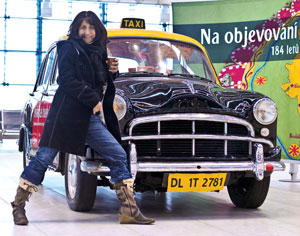 |
Nepali Times: Where did your interest in Bollywood dance forms come from?
Sangita Shresthova: When I was growing up in Kathmandu, my cousin owned a video rental store, and I became the passive consumer of whatever Hindi film he was copying. I enjoyed the song-and-dance sequences the most and was soon trying to copy the movements when I was alone. No one in my family danced, and I really credit Hindi cinema with giving me initial courage to even think about dance seriously. Several years later, I was a somewhat lonely and horribly homesick freshman at Princeton University. This is when Bollywood became a way for me to keep the semblance of a connection to a region of the world I missed terribly. But, it was really at MIT in the Comparative Media Studies program where I finally realised that my apparently disparate interests in dance, media, South Asia and globalisation all connected through Bollywood dance. There was no looking back after that.
And where is the Czech connection in all this?
Well, my mother is Czech, so that was probably the first connection. Beyond that, I was lucky to be in Prague when a renewed interest in Hindi cinema was just beginning to take shape. My friends and I started the Prague Bollywood Festival, later renamed as Prague Indian Film Festival, in 2002. The festival really became a place where I could reflect on what Bollywood means to the largely non-South Asian fans and audiences in the Central Europe. I also got to observe how these meanings changed over time. These observations led me to question what Bollywood means in other geographies.
 |
As a dancer yourself, what for you is the most inspiring part of Bollynatyam as a genre?
Bollynatyam is a term I use to describe my approach to Indian dance. It is not a technique, it is also not a set vocabulary of movements and gestures. Rather, it is an approach that situates Indian classical and Bollywood dances within a historical and cultural continuum to recognise contemporary trends while respecting past events that contributed to their existence. For example, a gesture is laden with meaning in Indian classical dance. When it is "borrowed" in a Bollywood sequence this meaning should be considered carefully. This does not mean that this gesture should not be borrowed at all. It just means that the borrowing should be done with respect and awareness. Similarly, the translation of Indian dance across media forms, into film and new media, can and in my opinion should be informed by the visual cultures of these dance forms. So, in effect, Bollynatyam is a contemporary and culturally sensitive approach to remixing Indian dance.
But there are now more and more Bollywood films without dance numbers, is the dance form going to be extinct?
I think that we are going to see a further segmentation of the Bollywood film genre. Some films will continue to feature dances as integral narrative elements of the tried-and-tested blockbuster. Others will delve into different narrative conventions, including those that do not include dance. In many ways, this is not new. There have always been Hindi films without song-and-dance sequences. Who knows? The current trend toward segmentation may even allow dance to re-emerge as a central and well thought through and choreographed theme in some films.
Read also:
Straight from the hip


